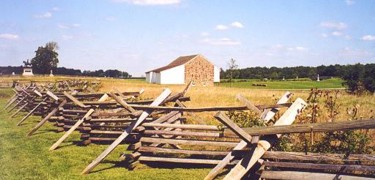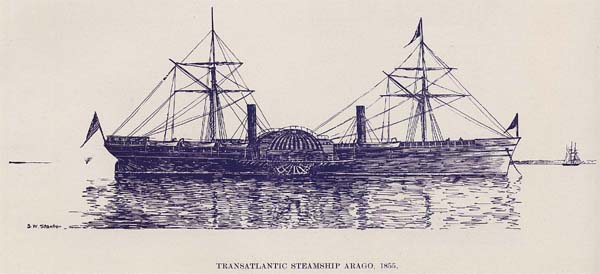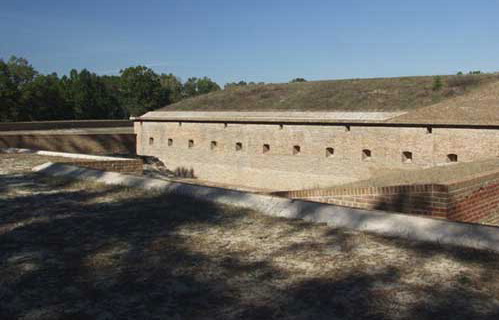History of the Second Connecticut Volunteer Light Battery
| The Second Connecticut Light Battery was organized in the city of Bridgeport in the month of August, 1862, and was mustered into the United States service on the 10th of September of the same year “for three years or during the war." |
|
The Battery left Camp Buckingham at Seaside Park on the 15th of October, 1862, for Washington, D. C., marching as far as New York city, and thence by rail, and went into camp at Bladensburgh Toll Gate.
On the 12th of December following, the Battery marched to Fairfax Court House and joined the second brigade of General Casey's division under command of General Stoughton. Its first smell of gunpowder was in repelling a night attack of Stuart's cavalry at this place.
In the latter part of January, 1863, the Battery was ordered to Wolf Run Shoals, where it remained until the 25th of June, guarding the "defenses of Washington." Here occurred many of the most pleasing incidents of its camp life. The camp was pleasantly located; but four men died.
When the Army of the Potomac followed Lee into Maryland and Pennsylvania, the Battery was ordered, on June 25th, to the Artillery Reserve, Army of the Potomac, under command of General Tyler, joining it at Edwards Ferry and marching thence via Frederick City and Taneytown to Gettysburg. On leaving Wolf Run Shoals eleven hundred rounds of fixed ammunition were destroyed for want of transportation. On arriving at Gettysburg on the afternoon of Friday, the second day of the battle, the Battery was ordered into position to the left of the center, where the enemy made a bold but ineffectual attempt to break through our lines, and just as the gallant Sickles was being borne to the rear. |
|
The Battery was in position for fifty-six hours consecutively, and a portion of the time in the fiercest of the fight, yet it escaped, providentially, without the loss of a man and with only three slightly wounded. The Battery lost but three horses, and one caisson exploded by the enemy's shell. |
The McPherson Farm, Gettysburg, PA |
|
On the 5th of July the Battery left Gettysburg for Frederick City, reaching there on the 6th and remaining there until the 18th, encamped with the Seventh New York State Militia. From thence the Battery went to Washington, reaching there on the 20th, and went into camp at Camp Barry.
On the 18th of August the Battery embarked at Alexandria for New York to aid in enforcing the draft. Reaching New York on the 22d, it went into camp in the City Hall Park, and from thence sections of the Battery were sent to East New York, Troy, Albany, Kingston, and Tarrytown. Up to this date the Battery had lost five men by death, six by desertion, fifteen by discharge, and fifteen were sick in hospital.
After the draft in New York had taken place the Battery returned to Camp Barry, remaining there until ordered to the Department of the Gulf. |
|
Steamship Arago |
On the 24th of January, 1864, the Battery proceeded to Baltimore, and on the 27th of January embarked on the steamship "Arago" for New Orleans, reaching there on the night of the 5th of February, and going into camp at Algiers.
On the 1st of March the Battery was ordered to Brashear City, where it remained until June 17th, with one section a portion of the time at Thibodeaux, when it returned to Algiers.
On the 30th of July the Battery left Algiers for Dauphin Island, Mobile Harbor, under command of Lieutenant Hotchkiss, leaving Captain Sterling in the hospital.
On August 3d we reached Dauphin Island, and on the 5th participated in the attack upon Fort Gaines in the rear, while Admiral Farragut led his fleet into Mobile Bay, passing Fort Gaines and Fort Morgan, and attacked and captured the rebel ram “Tennessee.”
The Battery witnessed the surrender of Fort Gaines, and on the 20th crossed to the rear of Fort Morgan and assisted in the bombardment of that stronghold. For twenty-four hours shot and shell poured in upon the fort from land and sea. The citadel was set on fire in the night, and at early dawn a white flag signaled the surrender. On the 28th the Battery crossed Mobile Bay to Cedar Point, and on the 10th of September returned to Algiers. On the 19th the Battery left Algiers and went into winter quarters on St. Charles Street in New Orleans. On the 15th of November the Battery was ordered to the mouth of the White River and went into camp there on the 20th. |
|
On the 19th of January, 1865, it left White River and went into camp at Kennerville, ten miles above New Orleans, and remained there until the 10th of February, when it was ordered to Greenville. On the 19th it broke camp at midnight and before daylight the next morning was at Hickock's Landing on Lake Pontchartrain, where the Battery was dismounted and transported to Fort Morgan, arriving there on the 22d. On the 26th it sailed for Barancas and remained there until the 11th of March, when it marched to Pensacola.
|
Fort Barancas, Pensacola, Fl. |
| On the 20th of March the Battery commenced its march to Blakeley, through the Black Swamp. After crossing Pine Barren Creek it came upon a rebel brigade under command of Brig.-General Clanton, who was captured, with upwards of one hundred prisoners, the rest escaping across the Escambia River and burning the bridge after them. The next day Pollard was visited and found to be evacuated, and passing around the head of Perdido River the Battery struck the stage road to Blakeley. On the morning of the 2d of April rebel skirmishers were encountered in the vicinity of Blakeley and pursued into their fortifications. Our lines were gradually drawn closer until the 9th of April, when the enemy's works were charged upon and captured, and the last grand battle of the war was fought, and on the very day of Lee's surrender at Appomattox Court House. Our loss was one man blown up by a torpedo in going to the fort as a spectator just after the fort was taken. On the 20th the Battery took transports for Mobile, and the next day started up the Alabama River, going to Selma, reaching there on the 27th and remaining until the 12th of May, when a return was made to Mobile.
In July came the order for the Battery to return to Connecticut to be mustered out. The Battery was turned over to the United States Quartermaster; the men went to New Orleans and soon after sailed for New York, and on the 9th day of August, 1865, were mustered out at New Haven.
During the three years the Battery traveled or marched about six thousand miles. 387 horses were drawn. On leaving Washington 87 were turned over to the quartermaster and 95 on leaving Mobile, thus using up in the three years 205. The Battery entered the service with the James Rifle, but exchanged it for the three-inch ordnance rifle-gun on going to the Department of the Gulf. It is a remarkable circumstance that during its three years of active service not a member of the Battery was killed in battle. |
|
Engagements
Gettysburg, PA., July 3, 1863. Fort Morgan, Ala., Aug. 19, 1864.
Fort Gaines, Ala., Aug. 6, 1864. Near Blakely, Ala., April 5 to 9, 1865. |
.
Casualties Second C. V. Light Battery
|
Killed |
Drowned |
Died |
Discharged disabled |
Total |
|
1 |
1 |
17 |
8 |
27 |
|
Editor’s Note: This is the eighth monthly installment of the history of Connecticut’s service in the Civil war, as published in the RECORD OF SERVICE OF CONNECTICUT MEN IN THE WAR OF REBELLION, 1861 TO 1865. (Transcribed by Staff Sergeant Brett W. Wilson, Administrative Assistant to the USPFO for Connecticut). |




